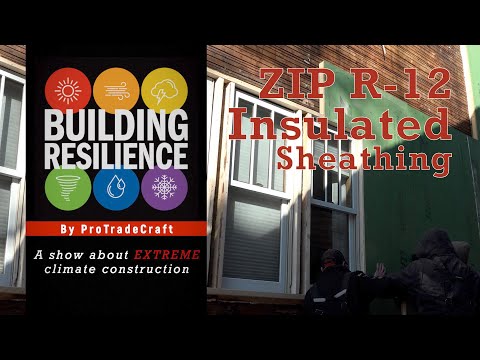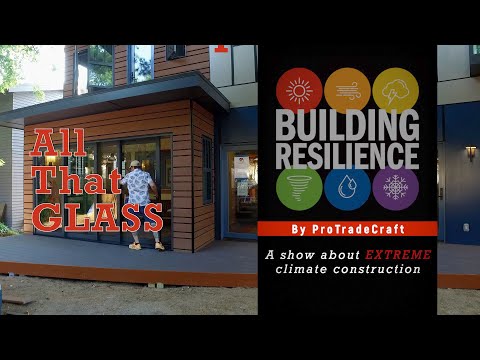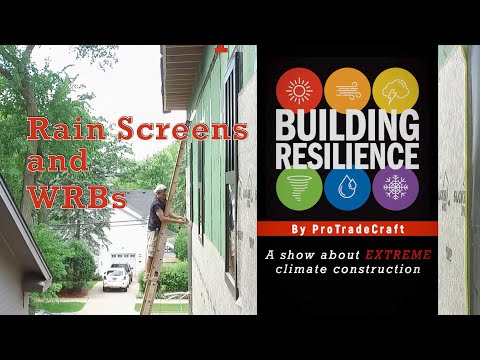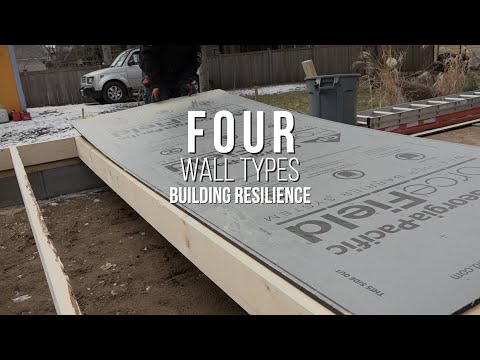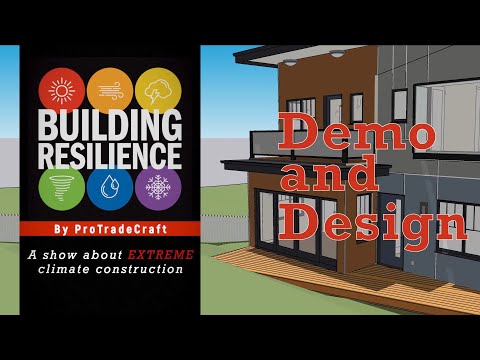Last time on Building Resilience, we were pulling sheets off the pile of ZIP System R-12 Insulated sheathing, notching them around pipes, and nailing them to the walls.
That’s simple enough for new construction, but when bridging new and old, sometimes the old framing is a little less than plumb.
"On this wall, we’ve got the existing house meets new construction. The existing house does kind of a twist and lean which is pretty typical for balloon-framed houses, they tend to have a little bit of a pull toward the inside.
So, we’re perfect at the bottom; we’re pretty imperfect at the top. And that’s OK; we’ve got a furring strip shim in there, planing it out. By the time we get about six feet into the existing house, we’re able to go flush against the sheathing again."
The main challenge was not that, though it was creating backing for the windows, which are fastened through the jambs rather than through nailing fins. This meant coming up with a suitable window buck design.
"I normally don’t like bucks. So we came up with this system for bucks that were concealed. There was a question about how well it would work, but we’ve really got it dialed in now; we’re almost friction-fitting these things in place.
We’ve got two beads of low-expansion foam that we’re putting in there—just a little belt and suspenders to make sure we’ve got a good air seal around those bucks.
Fenestrations are the weak part of the system and we want to make sure we don’t have any air flow in and around the windows, that could cause funky condensation around the units, and that would be bad."
And THAT brings us back to where we began this journey, in the middle of the story, in the middle of the country, hightailing it home in a quarantine pod.
The jobsite became a little more desolate for a little while as deliveries slowed, subs postponed work, and everyone sort of went into slow-motion mode.
Construction was deemed essential, so at least the crew could work. Fortunately, it is a large house, that affords all kinds of separation.
The main objective, as noted in the pilot episode, was installing the Skycove from Marvin. It is a glass cube that bolts to the side of the house, made for relaxing and stargazing.
There were a couple of obstacles to the installation, though.
First, no one had ever installed one before..
Second, a crane is an essential piece of equipment for installation because the Skycove needs to align with the rough opening, and it needs to be bolted in place plumb, level, square, and even.
The solution to the first obstacle was technological:
"The engineers were on the phone with us while we were installing it via Zoom. I think we were flying a drone, on a Zoom call and trying to manhandle some big drills to get the bolts into place.
It was five hours that went by in about 30 minutes.
The solution to the second one was mechanical:
MA: The site has no alley, so everything comes in through the street, and we’re up on a hill and we’re set back a ways from the street, and then there’s that giant pine tree in the back.
So some of the things that we might have done on another site weren’t available to us.
We have a thing called a rocket crane that picked up the Skycove unit from the street while it was still boxed—at 1,100 pounds—and brought it up between the two houses in an area of level ground.
Then the cat picked it up and brought it to the back yard, where we unboxed it and then we moved a bunch of earth up next to the house because we hadn’t done our backfill yet.
So we moved a few thousand yards of earth and we laid out a bunch of Advantech for the bobcat to have a somewhat stable platform to drive on.
Then he picked up the unit, brought it back there, and the skill of this driver was something. We’re trying to lift this large object up fourteen feet in the air, square it on the opening, and in this process make sure that we’re level and plumb.It wasn’t the kind of scenario where you could tap it a little to the left, or shim it with a wood shim or anything like that.
It really required a lot of coordination between the driver and the crew on the inside of the window communicating what we wanted him to do, making little micro-adjustments until we could get it close enough that we could use the come-along bolts that pull the unit fully in. So it starts out a little at an angle, and we slowly cranked it into place."
The problem with using a skid steer loader, though, is hydraulics. A load can hang off a cable all day long without ever moving. Hydraulics are no cable. Sure, they’re great, but they require constant attention to maintain the correct pressure on.
Because of physics.
So it kind of meant that they had to work quickly, doing something no one had ever done, without ANY adult supervision. OK, there were engineers on a Zoom call, but really, Michael was the closest thing to adult supervision on the job, and that is a scary proposition.
"The attachment point is not through the face of the material, it’s through the side of the material. So these steel posts slide into the opening of the framing. And from there, we drill out through our wall studs and we attach a series of lag screws through that.
So we’re pushing 3/4 -inch lag screws through four studs to get it in place."
Of course, there’s also that matter of being the first one to sit in it
When we decided that we thought we had it secured and we told the Bobcat that he could back out, there was a very pregnant pause as we wondered if it would shift suddenly, or you know, rip itself off the house.
Most people have now stood in it worked in it, and it is incredible stable.
But that’s not all that Marvin sent down from Warroad. They also sent some fiberglass frame triple-glazed casement windows. If Skycove hadn’t muscled its way into the show, these windows would be the star because they are beautiful, durable, and energy efficient as heck.
Another show-stopping product sent down on the truck is the four-panel sliding stackable doors that open pretty much the whole wall.
"and you can see over here, this is the new modern multi-slide stacking door from Marvin.
And it provides an incredible view to the exterior.
And what’s really cool about this thing, is that the whole thing opens up."
And that opens up the opportunity to take a closer look at how those doors and the Marvin Modern casement windows are installed in the next episode.
Stay tuned and stay resilient.
